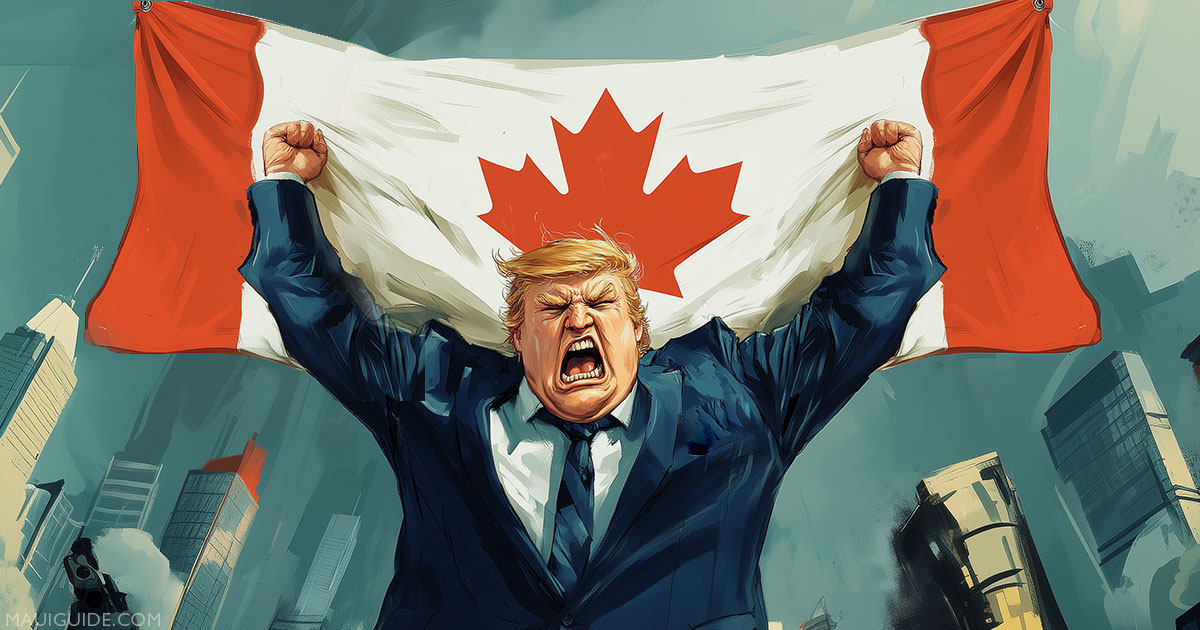Canada has long ranked among Hawai‘i’s top international visitor markets, second only to Japan in terms of annual arrivals. Canadians typically visit Hawai‘i in the winter months to escape the colder climate, boosting the islands’ hospitality sector during shoulder or slower U.S. travel seasons.
However, a series of public statements from former President Donald Trump—criticizing Canada’s trade policies and threatening new tariffs March 1st—has triggered a wave of media attention and has already influenced Canadian consumer sentiment, including travel behavior.
Trump has agreed to hold off on imposing the 25% tariffs on Canada and Japan for at least 30 days in exchange for both countries solidifying their borders. This is most likely his way of using threats to force cooperation from both countries.
Amid currency headwinds (a weaker Canadian dollar) and rising travel costs, some Canadian visitors are now stating that Maui and other Hawaiian Islands have become “too expensive”, especially when factoring in potential new tariffs or political tensions. Early anecdotal reports from tour operators in Western Canada suggest a decline in winter bookings for the upcoming season. Trump’s rhetoric, proposed tariffs, and Canadian sentiment is changing Hawai‘i’s reliance on the visitor industry.

Significance of Canadian Tourism to Hawai‘i
Pre-Pandemic Arrivals:
Prior to COVID-19, Canada was Hawai‘i’s second-largest international source of visitors after Japan. In 2019, Hawai‘i welcomed approximately 540,103 Canadian tourists, with total spending surpassing $1.07 billion.
Seasonal Patterns:
Canadians disproportionately visit during the cooler months (November through March). This winter “escape” travel is crucial for supporting hotel occupancy and spending in what could otherwise be a slower season for Hawai‘i’s tourism-dependent businesses.
Spending Habits:
On average, Canadian travelers stay longer (over 12 days on average) than many other international visitors, and they often rent condos or visit multiple islands. The extended length of stay translates into higher per-visitor spending on lodging, food, entertainment, and activities in Hawaii.

Exchange Rate Pressures
Another consistent factor influencing Canadian arrivals is the exchange rate between the Canadian dollar (CAD) and the U.S. dollar (USD). When the CAD weakens, Canadians’ purchasing power in Hawai‘i falls, making vacations more expensive. Currently, the exchange rate hovered around $1 CAD = $0.70 USD, a notable decline from near parity a decade ago. This currency gap, combined with steep inflation in food, lodging, and airfare, already contributed to Canadians’ sentiment that Hawai‘i is becoming “too expensive.”

Impact on Airline and Tour Packages
Tour operators like WestJet Vacations and Air Canada Vacations typically offer direct flights from Canadian cities (Vancouver, Calgary, Toronto) to Kahului (Maui) and other Hawai‘i destinations. In late 2023, some carriers reported softened demand for spring 2024 packages to Maui. To maintain load factors, airlines considered discounting fares, but given higher operational costs (fuel, staffing, etc.), significant fare cuts were not always feasible.

Anxiety in Hawai‘i’s Tourism Sector
Interviews with several Maui hospitality managers published in local newspapers reveal growing concern about the possibility of losing Canadian visitors—especially on top of the recent blow to West Maui from the August 2023 wildfires. Although Canadians historically concentrate in South Maui (Kīhei, Wailea) and Ka‘anapali as well, the entire island economy benefits when Canadians visit. With uncertainty surrounding future U.S. tariffs or political stances, some hotels have already shifted marketing budgets to alternative markets (mainland U.S., Japan, Oceania) to hedge the risk of Canadian cancellations.

Long-Term Scenarios
Modest, Short-Lived Impact
If tensions recede or are overshadowed by other global events, Canadian travel to Hawai‘i may return to normal cyclical patterns.
Prolonged Boycotts and Lower Demand
Continued hostile rhetoric and any official tariffs could reinforce a sense of unwelcome, leading to multi-year declines in Canadian visits. The island hospitality sector would adjust by courting alternative markets (mainland U.S., Japan, South Korea, Australia).
Wider U.S.-Canada Economic Rift
In a worst-case scenario where reciprocal tariffs escalate, Canadian disposable income for U.S. travel might shrink overall. Hawai‘i’s tourism might permanently lose a portion of its Canadian base, forcing deeper transformation in marketing and development.

If Hawai‘i successfully communicates its distance from mainland political controversies, the long-standing Canada–Hawai‘i relationship may well endure, albeit with temporary dips in arrivals. For now, however, the combination of cost concerns and political uncertainty has made some Canadians think twice about visiting Maui, underscoring the outsized influence national politics can have on local economies thousands of miles away.


My wife and I loved visiting Hawai’i. My first visit was in 1983, and I’ve always loved coming back. This year we wanted to visit the wonderful islands again. Given the price trends, we hesitated. But political developments also made us hesitate just a few weeks ago. In the meantime, we are certain that we will not visit a country again that nationalist and fascist politicians and billionaires are not only changing its basic features, but are even illegally seizing power without resistance.
We’ll be visiting our favourite area of Hawaii, the Waikoloa area on the big island, in 2 weeks and we’re looking forward to it…just 2 of us, just 2 weeks. We had planned a return in the fall, 12 of us for 10 days including 4 who plan a longer stay but we are reconsidering now that President Trump has repeatedly said he intends to take over our country. It’s not just that but the mass firings of independent inspectors and agencies that ensure air, food and water safety, anti-pollution and occupational health and safety guidelines will leave all US states far less safe than we’ve come to expect.
Let’s hop those positions were eliminated due to corruption. What he says about taking over the country is ridiculous, but that’s how he works. He bullies authority into a lesser deal. We don’t agree with everything his administration is doing, but we’re hopeful that it’s mostly posturing and getting rid of inefficiencies. It’s something we’ll have to wait and see for.
We have been coming to Maui for years.No more,that Orange pig 🐖 you have for a President screwed your islands .We will be going to Mexico and the Caribbean from know on.. Good luck,but you voted for him.O ya,we are Canadians.
In the 2024 U.S. presidential election, the majority of Hawaii’s votes went to Democratic candidate Kamala Harris, who received 60.59% of the vote. Thanks for the kind words.
We have been visiting Maui for many years (since 1984) and considered it our second home, often staying for a couple of months. We have built many friendships with other Canadians as well as Americans. The increase in accommodation prices, car rentals, airfares, food and the drop in the Canadian dollar has made it difficult to sustain another trip. Added to that, our current political situation makes visiting Maui unthinkable. Perhaps in four years should Mr. Trump and his partners be gone, we and many of our friends would definitely consider holidaying in your lovely country once more!
We love visiting Hawaii (have mainly visited Maui) and really would like to come back. However, we have decided not to for an indefinite period of time. This is partly due to the difference in our collars, but we were willing to just cut some of our expenses, but still come to Hawaii as we considered it worth it. However, now that President Trump has threatened our country with statements about making us the 51st state, and then putting high tariffs on us, we definitely will not travel anywhere in the U.S.A., but will either spend our holidays at home or go to other countries. President Trump has insulted our country by thinking that we will just roll over to his wishes, and he has insulted our leaders on many occasions. We love our previous relationship with your country, but Canadians need to stand together at this time as proud and free Canadians, who wish to keep their own country, history and values intact. We hope that our countries can revisit their friendship and support in the future.
Yep, definitely a bummer. We do a lot of business with our friend in Canada. I do a lot of adverts in Canada and have definitely seen some boycotting types of comments on our ads, and we’re just a little local Jeep Rental company in Kona trying to have some fun with our guests. We didn’t ask for any of the Trump stuff.
I just did an ad offering free rubber ducks to Canadians as as token of appreciation, and recognition of the problem.
Aloha,
-Joe
We travel for our first trip to 2 islands April 16th. I’m trying to find out if it is still safe given the current issues.
We are Canadian. We are traveling ti Maui and Big Island.
We have canceled our usual Christmas trip to Disney but this trip is fully paid for.
Any thoughts?
Curious why you would think it wouldn’t be safe for a Canadian to visit Hawaii? To me, that worry doesn’t make sense.
This was posted on a different website of ours from Phil:
Your email appears to be blaming President Trump for Maui’s reduction in Canadian visitors.
I think the exchange rate of C$1 = US$0.69 likely has much more to do with this than tariffs. This exchange rate reflects the sad state of the Canadian economy which would barely be surviving if it weren’t for its trade with the U.S.
What items could Canadian visitors possibly be exporting to the US. that would be a factor in their visit to Maui?
I hardly think that Canadian visitors would be importing and bringing back large enough quantities of pineapple or local art to their home country for these tariffs to be a significant factor.
The only tariff that I can think of that might discourage Canadian visitors would be tariffs on hotel rooms and restaurant bills. But the U.S. has no plans to impose these tariffs. Why would they? They bring foreign exchange to the U.S. which helps balance the trade deficit which is desirable.
Most countries around the world including Canada, Europe and Asia have been imposing tariffs on U.S. imports for many years. I don’t believe that has stopped Americans from travelling abroad.
Your eagerness to repeat this false and unfounded political claim from the “MauiGoodness” hack website reveals your bias and your hatred for our President and our country.
Perhaps your blatant political bias will fly among your little audience in Maui. But you’re sadly mistaken if you think everyone on the mainland shares your views. In fact, 77 million Americans voted for our President. Not to mention that your former congresswomen, Tulsi Gabbard, is now a member of President Trump‘s cabinet.
I own real estate in Maui as do many of my friends. I will not hesitate to avoid doing business with your company and will certainly share this with the many I know who also own property and frequent Maui.
This article was written because we’re getting a lot of messages from Canadians saying they won’t visit until Trump is out of office. Not because they personally are paying tariffs but because of his actions and comments towards their country.
And pretty sure this article was written in a unbiased factual manner.
Canadians spend significantly more per person on American goods than Americans spend on Canadian goods, with Canadians consuming an average of $8,500 worth of American goods compared to Americans consuming $1,208 worth of Canadian goods.
If you take population of both countries into account the “trade deficit” that the Trump administration claims is so bad it is MUCH MUCH smaller than Trump would have you believe.
Of course as Canadians we are not wanting to pay tariffs, but the weaker Canadian dollar also plays a part, and finally add your president into the mix, and it just makes it that much easier not to spend our money in the US or on American made goods.
I saw a sign the other day and it sums it up perfectly;
Elect a Clown
Expect a Circus